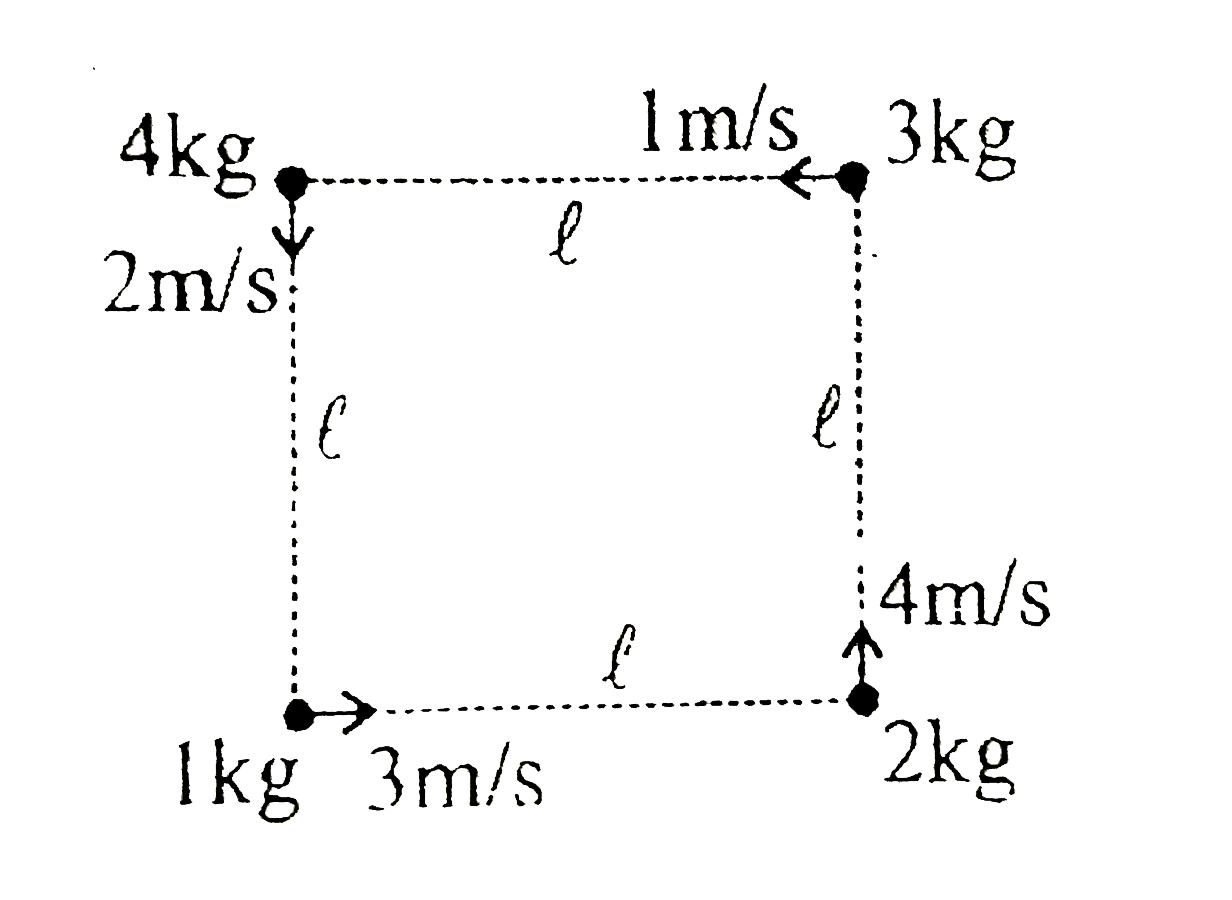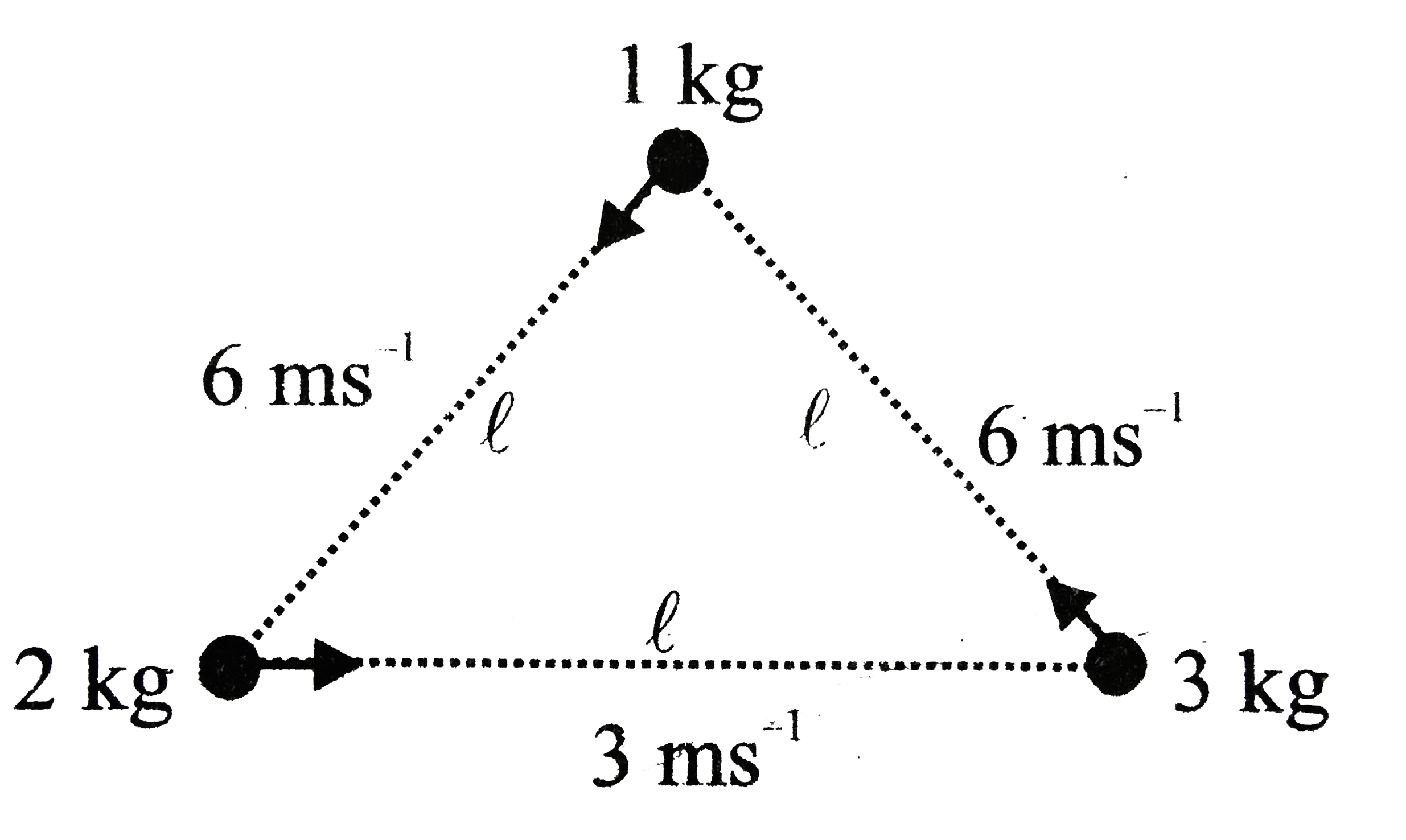Four particles situated at the corners of a square of side ‘a’ move at a constant speed v. Each particle maintains a direction towards the next particle in succession. Calculate the time particles will take to meet each other.
av
a2v
a3v
2a3v
The correct Answer is:A
To solve the problem of four particles situated at the corners of a square of side 'a' moving towards each other, we can follow these steps:
Step 1: Understand the Configuration
The four particles are located at the corners of a square. Let’s label the corners as A, B, C, and D. Each particle moves towards the next particle in a clockwise direction:
- Particle A moves towards Particle B
- Particle B moves towards Particle C
- Particle C moves towards Particle D
- Particle D moves towards Particle A
Step 2: Analyze the Motion
Since each particle is always moving towards the next particle, they will spiral inward towards the center of the square. The distance between any two adjacent particles (e.g., A and B) is initially 'a'.
Step 3: Determine the Relative Velocity
To find out how long it will take for the particles to meet, we need to consider the relative velocity of one particle towards another. For example, consider Particle A moving towards Particle B. The speed of Particle A is 'v', and since it is directed towards Particle B, we need to find the component of this velocity in the direction of the line joining A and B.
Step 4: Calculate the Time to Meet
1. The distance between A and B is 'a'.
2. The relative velocity of A towards B is 'v' because Particle A is moving directly towards Particle B.
3. The time taken t for Particle A to meet Particle B can be calculated using the formula:
t=DistanceRelative Velocity=av
Step 5: Conclusion
Since all particles are moving towards each other in a similar manner, they will all meet at the same time. Therefore, the time taken for all four particles to meet at the center of the square is:
t=av
Final Answer
The time taken for the particles to meet each other is av.
---
The four particles are located at the corners of a square. Let’s label the corners as A, B, C, and D. Each particle moves towards the next particle in a clockwise direction:
- Particle A moves towards Particle B
- Particle B moves towards Particle C
- Particle C moves towards Particle D
- Particle D moves towards Particle A
Since each particle is always moving towards the next particle, they will spiral inward towards the center of the square. The distance between any two adjacent particles (e.g., A and B) is initially 'a'.
To find out how long it will take for the particles to meet, we need to consider the relative velocity of one particle towards another. For example, consider Particle A moving towards Particle B. The speed of Particle A is 'v', and since it is directed towards Particle B, we need to find the component of this velocity in the direction of the line joining A and B.
1. The distance between A and B is 'a'.
2. The relative velocity of A towards B is 'v' because Particle A is moving directly towards Particle B.
3. The time taken t for Particle A to meet Particle B can be calculated using the formula:
t=DistanceRelative Velocity=av
Since all particles are moving towards each other in a similar manner, they will all meet at the same time. Therefore, the time taken for all four particles to meet at the center of the square is:
t=av
The time taken for the particles to meet each other is av.
Topper's Solved these Questions
- BOOK - MOTIONCHAPTER - KINEMATICSEXERCISE - EXERCISE 2 OBJECTIVE PROBLEMS (Level-2)26videos
KINEMATICS
- BOOK - MOTIONCHAPTER - KINEMATICSEXERCISE - EXERCISE 3 SUBJECTIVE PROBLEMS (Level-1)20videos
KINEMATICS
- BOOK - MOTIONCHAPTER - KINEMATICSEXERCISE - EXERCISE 1 OBJECTIVE PROBLEMS103videos
KINEMATICS
- BOOK - MOTIONCHAPTER - HYDROSTATIC, FLUID MECHANICS & VISCOSITYEXERCISE - EXERCISE -3 (SECTION-B) PREVIOUS YEAR PROBLEM7videos
HYDROSTATIC, FLUID MECHANICS & VISCOSITY
- BOOK - MOTIONCHAPTER - KINETIC THEORY OF GASES EXERCISE - EXERCISE-3 SECTION-B16videos
KINETIC THEORY OF GASES
Similar Questions
Six particles situated at the corners of a regular hexagon of side a move at a constant speed v. Each particle maintains a direction towards the particle at the next corner. Calculate the time the particles will take to meet each other.
View SolutionFour particle each of mass 1kg are at the four orners of a square of side 1m . The work done to move one of the particles to infinity
View Solution
Knowledge Check
- Question 1 - Select One
Four particles of masses 1 kg, 2 kg, 3 kg, and 4 kg are situated at the corners of a square and moving at speed 3ms−1,4ms−1,1ms−1 and 2ms−1 respectively. Each particle maintains a direction towards the particle at the next comer symmetrically. The momentum of the system at this instant is
 A3kgms−1B5kgms−1C6kgms−1DZero
A3kgms−1B5kgms−1C6kgms−1DZero - Question 2 - Select One
Three particles of masses 1kg,2kg and 3kg are situated at the corners of an equilateral triangle move at speed 6ms−1,3ms−1 and 2ms−1 respectively. Each particle maintains a direction towards the particles at the next corners symmetrically. Find velocity of CM of the system at this instant
 A3ms−1B5ms−1C6ms−1Dzero
A3ms−1B5ms−1C6ms−1Dzero - Question 3 - Select One
Four particles each of mass m are placed at the vertices of a square of side l. the potential at the centre of square is
A−2√2GmlB−3√2GmlC−2GmlD−4√2Gml
six particles are situated at the corners of a regular hexagon. These particles start moving with equal speed of 10 m/s in such that velocity of any one particle is directed towards the next particle. Find the rate (in m/s) at which length of a side of the hexagon is decreasing.
View SolutionThree particle A, B and C situated at the vertices of an equilateral triangle starts moving simultaneously at a constant speed "v" in the direction of adjacent particle, which falls ahead in the anti-clockwise direction. If "a" be the side of the triangle, then find the time when they meet
View SolutionFour particles each of mass 'm' are placed at the four vertices of a square 'a' .Find net force on any one the particle.
View SolutionA particle moves along a semicircular path of radius R in time t with constant speed. For the particle calculate
View SolutionA particle moves with constant speed v along a circular path of radius r and completes the circle in time T. The acceleration of the particle is
View Solution

